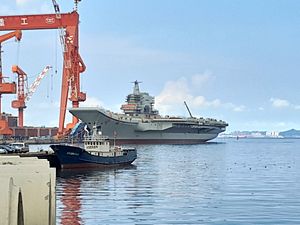As Ankit Panda reported yesterday, firm evidence has now emerged regarding the construction of China’s second indigenous aircraft carrier. Provisionally dubbed the Type 002, the new carrier will likely displace in the 85,000 ton range, and operate aircraft in CATOBAR configuration. The propulsion system remains uncertain, although analysts at CSIS have guessed conventional; China has never constructed a nuclear-powered surface warship.
This construction represents the rapid pace of China’s efforts at carrier construction. Dalian shipyard laid down the Type 001A in 2013, completing the ship last year (she has yet to enter full service). Given the progress on Type 002, it is clear that the People’s Liberation Army Navy (PLAN) decided it did not need to wait for experience with Type 001A before starting the design and construction process of the new carrier. This is perhaps a touch surprising, given that Type 002 is larger and will have a much different configuration than her predecessor.
To be clear, this will be the largest and most advanced aircraft carrier ever built outside the United States. It will likely be larger than even the Ulyanovsk class carriers laid down, but never completed by, the Soviet Union. This ship represents China’s maritime ambitions, and tells us a great deal about how much Beijing values the maritime domain. The construction would seem to conclusively demonstrate that China wants a long-range maritime force with expeditionary and high-intensity warfare capability. This will not surprise anyone familiar with the PLAN’s long-term development strategy, but it does seem to confirm that fleet’s investment priorities.
Even if the carrier begins trials by 2022, it will be some time before it becomes a useful military asset. Liaoning and her new half-sister have undoubtedly offered the PLAN platforms for developing experience with carrier operations, but the CATOBAR Type 002 will bring an entirely new set of problems. Jumping from STOBAR to CATOBAR is not a process that any navy has ever undertaken, although India may try to join the club in the next decade. Thus, China will need to work through the pitfalls of the transition on its own.
The construction of the Type 002, along with the rest of China’s naval armament program, suggests that Beijing is not yet worried that a major economic slowdown will constrain its finances. Historically, states tend to respond to military austerity by skimping on their navies first, mostly because ships are large capital projects and because revolting sailors rarely lead military coups. The CCP has obviously determined that the current economic slowdown can be weathered. Indeed, it would be surprising if the PLAN does not begin construction of another carrier in short order, as it will require at least two ships to keep one permanently on station.
The views expressed here are his personal views and do not necessarily reflect those of the Department of Defense, the U.S. Army, the Army War College, or any other department or agency of the U.S. government.
































